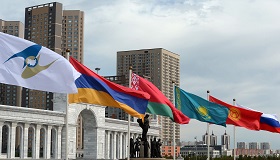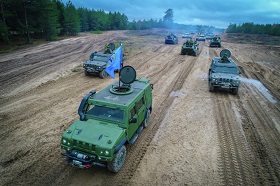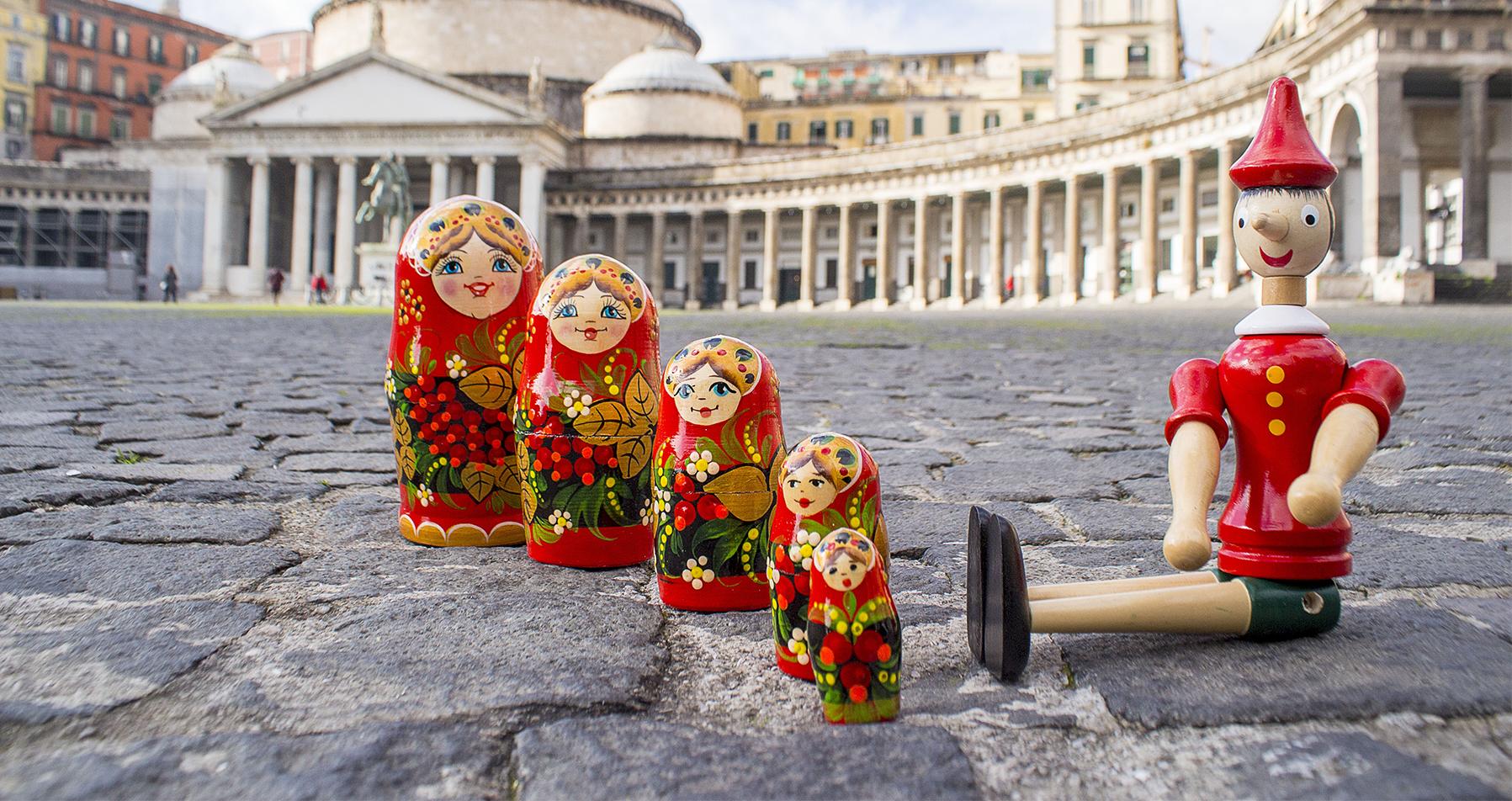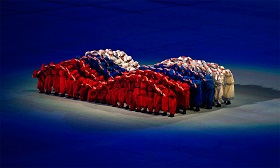Crises come and go, and life goes on. In early 2015, at the height of the Ukrainian crisis, RIAC Director General Andrey Kortunov wrote an article entitled “Seven Steps Beyond the Horizon of the Crisis” in which he proposed that we think about how Russia would build relations with the rest of the world “after Ukraine.”
Five years later and the crisis has brought about neither compromise nor the collapse of Ukrainian statehood, and relations between Russia and the West are developing more along the lines of a conflict than anything else. It is against the backdrop of this state of affairs that we asked Dr. Kortunov to revisit some of the fundamental questions that determine Russia’s foreign policy today and in the coming years.
1. Where can international resources be found to aid Russia's modernization?
2015: Throughout the post-Soviet period, Europe (and to a much lesser extent — the United States) remained the primary source of investment, technology, managerial decisions and standards for Russia. There is little doubt that the relationship with the United States has been frayed for a long while, and we cannot rely on Japan in the present context of a bitter confrontation with Washington. But if we accept the premise that Russia will have to “return to Europe” in any case, then we should do our best today to make this “return” less complicated and painful.
2020: Russia’s involvement in the global economy remains lower than before the crisis began. Preliminary results for 2019 suggest that foreign trade averaged $665 billion per year, compared to $783 billion in 2014. What’s more alarming, Russia’s foreign trade actually fell last year (by $23 billion). And while trade with China has grown significantly, the European Union remains Moscow's main trade partner (making up approximately two-fifths of Russia's total foreign trade).
Despite a very successful 2019, foreign direct investment (FDI) is also down significantly compared to 2014, not to mention 2013. China, and Asia as a whole, have not become an effective alternative to EU countries as the main source of FDI for Russia, nor are they likely to in the near future. Hopes for a breakthrough in Russia's political and economic relations with Japan have thus far proven to be unfounded. Additionally, Asian FDI is mostly concentrated in the Russian energy sector.
So, the task of finding an international resource to aid Russia’s modernization is as relevant as ever. It would be safe to assume that China, India, the ASEAN countries and other non-Western actors will become increasingly viable as such a resource over the next five years. Still, it is by no means a given that Russia will be able to position itself as the most attractive target for Asian investment. It any case, it is vital that we try, first of all, to ease EU trade and economic sanctions (if not lift them altogether). Then, we need to ensure that U.S. secondary sanctions do not significantly impact Russia’s trade with its European and Asian partners (assuming that the U.S. sanctions are unlikely to be revised before 2024). Both of these goals involve making real progress in resolving the crisis in and around Ukraine. It’s all well and good posturing in defiance ("They're your sanctions, so you lift them") — the public tends to like that — but it's not really in the country's best interests.
2. What are the real prospects of Eurasian integration?
2015: The joint struggle with the crisis is certainly a prerequisite for the successful continuation of the project. But it is not the only necessary condition. It is equally important to offer the partners a clear and convincing picture of the long-term prospects of integration processes. These prospects should not boil down to the mere reasoning that world energy prices will rise sooner or later rise, and the Eurasian region will prosper again. The matter at hand here is not just restoring confidence in the economic model of our country’s development (and the current model should drastically change to this end in view), but restoring the attractiveness of Russian civilization, without which we are bound to lose all remaining allies and partners.
2020: The Eurasian Economic Commission has worked tirelessly over the past five years to create a legal and regulatory framework for deepening integration processes in the Eurasian Economic Union. Armenia and the Kyrgyz Republic joined the Union in 2015. The following year an agreement was signed on a free-trade area with Vietnam, followed by agreements on trade and economic cooperation with China, Iran, and so on. However, the share of Russia’s EAEU partners in its foreign trade turnover at the end of 2019 was less than 8 per cent (to compare, Germany’s EU partners make up 58 per cent of its foreign trade turnover). The recent spats between Moscow and Minsk on energy clearly point to the fragility of integration processes in the post-Soviet space.
Just like five years ago, the central unresolved problem for Russia is the lack of a model of socioeconomic development that would seem attractive and accessible to its neighbours. Russia has not become a leader among the CIS countries in terms of the development and implementation of structural economic reforms. In fact, in many areas, Russia lags far behind Kazakhstan, for instance. There is another issue that has not been appropriately addressed, and that is the low appeal of the Russian civilization as a whole. This is why, unfortunately, former Soviet countries continue to be "pulled" towards other regions. For example, China has continued to actively promote its Belt and Road Initiative in Central Asia over the past five years. The Western sanctions against Russia are another factor complicating the prospects of Eurasian integration, making the country "toxic", even for its closest partners. However, even if the EAEU integration project is implemented to its fullest and Russia experiences rapid economic growth over the next five years, the combined potential of the EAEU countries will not be sufficient for the Union to become a global centre of power capable of competing on equal terms with the United States, the European Union and China (and soon India) by 2025, or even 2030. One way or another, the EAEU member states will have to integrate into a larger association, whether it be together or as separate entities.
3. Is it possible to escape another arms race with the West?
2015: Half a century ago, the USSR and the United States began intensive negotiations that resulted in the conclusion of a number of historic agreements, first on the limitation and then on the reduction of the strategic arsenals of both countries. Perhaps it is time to return to this experience of the epoch of global confrontation between the two superpowers, since any "strategic partnership" between Moscow and Washington in the foreseeable future is out of the question.
2020: Unfortunately, U.S.–Russia relations have continued to deteriorate over these past five years. The international treaty framework of bilateral arms control turned out to be almost completely destroyed, which even the most hardened of pessimists could hardly have foreseen in 2015. It is looking increasingly likely that we will not be able to preserve the New START as the last significant strategic arms treaty. This may very well be followed by the erosion or complete collapse of numerous multilateral agreements, such as the Non-Proliferation Treaty, the Comprehensive Nuclear-Test-Ban Treaty, the Chemical Weapons Convention and others. With a certain trepidation, we can argue that Russia has thus far managed to avoid a full-scale arms race with the collective West. Moscow's defence spending has been declining steadily in recent years: Russia was seventh in the world in military spending in 2018, eighth in 2019 and will likely be ninth in 2020.
However, none of this means that the threat of an arms race has disappeared. Russia is in greater danger than it was five years ago of falling behind its potential opponents technologically, and the possibility of a military conflict erupting as a result of a technical error or unintentional escalation is very real. Therefore, the key task for the next five years is to create a new arms control mechanism which should probably be multilateral and impose restrictions not only on the number of nuclear warheads and carriers, but also on new destabilizing areas of the arms race (cyber, space, artificial intelligence, automated systems, high-precision weapons, etc.). Additionally, Russia is faced with the task of optimizing the algorithms for its involvement in regional conflicts. For example, Russia has now been running its operation in Syria longer than the Soviet Union was involved in the Second World War. On three separate occasions, the Russian leadership has announced that it would be curtailing the operation. Yet, we remain in this position of not knowing when it will actually come to an end.
4. What should be done with unrecognized states and territories?
2015: Of course, this isn’t about abandoning support in an instant to our friends and allies across the borders of our country. But this support should be made targeted, more transparent and efficient as well as less costly for Russia. It is possible and, apparently, even necessary. Likewise, it is possible and necessary to encourage the leaders of unrecognized states to enter into an active and extensive dialogue with their opponents, striving for consistent if slow progress in resolving these conflicts. It is no secret that in all unrecognized states, there are forces that are not interested in any dialogue and rely solely on maintained and even increased support from Moscow. But should Russian policy place a stake on these particular forces in the long run?
2020: Over the past five years, not a single unrecognized state or territory has been able to increase its international subjectivity in a meaningful way. And there is no reason to believe that these entities are about to gain diplomatic recognition any time soon. These states continue to depend heavily — whether directly or indirectly — on economic, political and military aid from Russia. In addition, they continue to face problems trying to form stable state institutions (the most recent example of this being the severe political unrest in Abkhazia in January 2020). Unrecognized states and territories continue to be a grave obstacle to building productive relations with Russia's neighbours in the post-Soviet space.
I’d like to hope that the recent reshuffle in the Kremlin will breathe new life into work in this area, particularly concerning shifting the emphasis from traditional post-Soviet geopolitics to issues surrounding the socioeconomic development of unrecognized states and territories. We should keep in mind, however, that this will be increasingly difficult to do as time progresses, since a significant part of the political and economic elites of these territories are quite happy to leech off Moscow. We cannot continue to focus on maintaining the status quo and dealing with emerging crises and conflicts forever. Instead, we need a strategic approach to resolving acute problems in the post-Soviet space.
5. How should a new immigration policy and relations with the Russian Diaspora be built?
2015: The times of readily available migration resources are over for us, while the need for such resources, in contrast, is growing. Therefore, the Russian migration policy should probably shift the emphasis from the administrative mechanisms of regulating migration flows (the Ministry of the Interior can cope with this perfectly well) to finding solutions to problems of migrants' adaptation and integration (which requires the combined efforts of the government, business, civil society, educational institutions, media and many other structures).
2020: The Federal Migration Service, which was responsible for dealing with issues related to the adaptation and integration of migrants into Russian society, was dissolved in 2016. This could not but have led to additional difficulties in managing migration, at least in the short term. On the other hand, Russia was "lucky" in the sense that migration from Ukraine rose sharply in the middle of the 2010s. To put it into numbers, almost 500,000 foreign nationals and stateless persons became Russian citizens in 2019, with some 300,000 coming from Ukraine. We should note, however, that 200,000 of these Ukrainians are residents of the unrecognized Donetsk and Luhansk people's republics. Nevertheless, the surge in migration flows from countries that are culturally proximate to Russia does not eliminate the problem of integrating migrants from regions that are further away both geographically and in terms of their culture. In all likelihood, the balance between the “near” and “far” abroad as migration donors will gradually shift towards the latter over the next five years.
At the same time, the number of Russians leaving to take up permanent residence in another country has also risen over the past five years. Official figures and independent estimates vary wildly, but in any case, we are looking at hundreds of thousands of the most educated, energetic and ambitious people from our country. This trend will inevitably continue over the next five years. Meanwhile, we are not doing a particularly good job at increasing the effectiveness of our work with the Russian diasporas — especially the so-called “new” diasporas that have started springing up in the West over the past 20 years. Many recent initiatives (most notably the infamous recommendations of the Ministry of Science and Higher Education of the Russian Federation put forward in July 2019 on developing contacts with foreign and international organizations and bringing in foreign citizens) clearly hinder our ability to improve work in this area, rather than help it.
6. What changes are needed in the mechanisms of using soft power?
2015: It sometimes appears that with regard to "soft power," we are moving not forward, but back to the tried and familiar, although archaic and often openly counterproductive, patterns of Soviet times. The question arises about whom in the future will be our primary target audience abroad: the political mainstream in the West and the East, or the right and left-wing radicals who do their utmost to undermine this mainstream? Placing a stake on radicals can yield quick and tangible results (primarily given the current political and social instability in many countries around the world). Still, in the long term, this approach may prove incorrect.
2020: The most successful example of Russia’s use of soft power in the past five years was probably its hosting of the FIFA World Cup in the summer of 2018, which had a massive impact on how people around the world see our country. New opportunities for promoting Russia's interests appeared in connection with the resumption of the country's participation in the Parliamentary Assembly of the Council of Europe, as well in the context of its work as part of international efforts to combat climate change. However, Russia’s demonstrations of solidarity with right-wing populists, especially in Europe (for example, the cordial reception of French right-wing leader Marine Le Pen in the Kremlin in March 2017 during the country’s presidential campaign) continue to irritate its most promising political partners. The hackneyed practice of positioning “Russian conservatism” in opposition to a deliberately caricatured image of “Western liberalism” has hardly been a success. The international community has not responded well to Russia’s increasingly bellicose foreign policy rhetoric, or the “militarization” of its foreign policy in general.
The Soviet experience still dominates the Russian concept of soft power, and this makes it challenging to develop working relations with the right people in both the West and East, particularly the younger generation. The geographic range of the Russian language is shrinking: every year, the number of Russian speakers drops by some 2 to 3 million people. It is clear that the effectiveness of Russian power will continue to suffer if we do not achieve a decisive socioeconomic breakthrough and become significantly more open as a society to the outside world.
7. What should the basis of the new Russian patriotism be?
2015: However, the modernization of Russia is far from possible without the unifying force of civil patriotism. As the experience of many other countries has shown, it is precisely the patriotic feeling that helps to endure losses and hardships, to cope with the challenges and difficulties typical for any period of social and economic modernization. Such mobilizing patriotism looks to the future, not to the past; it has more to do with hope than with memories, with all the undeniable significance of the latter for the national self-consciousness. It is appropriate to ask what kind of Russia we want to see in ten, twenty or thirty years. What country would we like to leave to our children and grandchildren? Maybe, it’s time to shift the focus from the persistent cultivation of a “besieged fortress” mentality to the democratic social development of our common future?
2020: We must admit that a new model of unifying civil patriotism has not appeared in Russia during these past five years. Right now, Russian society does not have a reliable and attractive image of what the country will look like in the future. Social mood indexes (life satisfaction, social optimism, and the country’s economic performance, political situation and overall development trajectory) has fallen by an average of 10 to 25 per cent over the past five years. Sociologists have pointed to the fact that the “Crimean Consensus” has lost its rallying power, and there is nothing to fill the gap.
Russian society is more divided in 2020 than it was in 2015, and one of the main dangers facing the country today is the spread of apathy and social nihilism, similar to what happened in the Soviet Union in the early 1980s. Attempts to supplant the civil patriotism that has emerged at the grassroots level with state nationalism imposed from above have not been particularly effective. In all likelihood, the task of creating and promoting a contemporary model of unifying civil patriotism over the next five years will not be solved not by government technocrats or political strategists, but rather by a new generation of public leaders who are only now beginning to enter the political arena.











